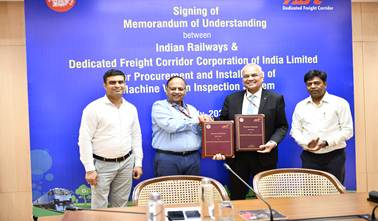Indian Railways, DFCCIL Partner to Deploy AI-Powered Train Inspection Tech
The agreement marks a significant milestone in Indian Railways’ ongoing mission to modernize its infrastructure, streamline operations, and reduce human dependency in critical inspection processes.

- Country:
- India
In a groundbreaking step towards embracing advanced technology and enhancing operational safety, Indian Railways has inked a Memorandum of Understanding (MoU) with the Dedicated Freight Corridor Corporation of India Limited (DFCCIL) to implement Machine Vision Based Inspection Systems (MVIS). This innovative, AI-driven solution is set to revolutionize the way rolling stock (train components) is monitored, with a sharp focus on automation, efficiency, and real-time safety alerts.
The agreement marks a significant milestone in Indian Railways’ ongoing mission to modernize its infrastructure, streamline operations, and reduce human dependency in critical inspection processes.
MVIS: The Future of Railway Safety and Maintenance
The Machine Vision Based Inspection System (MVIS) is a state-of-the-art AI/ML-based technology that leverages high-resolution cameras and machine learning algorithms. It is strategically installed wayside to inspect the under-gear and components of moving trains at high speed.
Here’s how the system works:
-
High-Speed Imaging: As trains pass through, MVIS captures detailed, high-resolution images of the rolling stock’s under-gear.
-
AI/ML Analysis: Using trained algorithms, the system analyzes these images to detect hanging, loose, broken, or missing components.
-
Real-Time Alerts: On spotting anomalies, the system triggers instant alerts to control rooms and relevant authorities for immediate action.
-
Preventive Maintenance: The early detection of faults allows for proactive repairs, significantly reducing the risk of accidents, service interruptions, or derailments.
This new system minimizes the need for manual inspections, boosts safety margins, and optimizes maintenance cycles, making it a game-changer in the Indian rail ecosystem.
MoU Signing Ceremony at Rail Bhawan
The formal MoU signing ceremony was held at Rail Bhawan, New Delhi, in the presence of senior leadership from both Indian Railways and DFCCIL.
Key dignitaries present included:
-
Shri Sumit Kumar, Director (Project & Development), Railway Board
-
Shri Jawahar Lal, GGM (Mechanical), DFCCIL
-
Shri B. M. Agrawal, Member (Traction & Rolling Stock), Railway Board
-
Shri Praveen Kumar, Managing Director, DFCCIL
These leaders emphasized the strategic importance of integrating machine vision and AI into core railway operations, and reiterated the goal of future-ready infrastructure that prioritizes passenger and freight safety.
DFCCIL’s Role and Deployment Plan
Under the terms of the MoU, DFCCIL will handle end-to-end implementation of the MVIS units:
-
Procurement
-
Supply
-
Installation
-
Testing and Commissioning
Initially, four MVIS units will be installed at high-priority locations across India’s freight corridors. The selected locations will cover key routes where both high-speed freight and passenger trains operate, allowing the system to serve dual safety functions.
DFCCIL, being at the forefront of building India’s dedicated freight corridors, brings the required technical and logistical expertise to deploy and scale such complex digital systems.
Why This Move Matters
1. Improved Operational Safety
MVIS acts as a real-time digital sentinel that continuously monitors rolling stock without halting operations—dramatically reducing the chance of undetected mechanical faults causing accidents.
2. Enhanced Efficiency
Manual inspections, which are labor-intensive and time-consuming, will be significantly reduced, freeing up personnel for higher-value technical work.
3. Predictive Maintenance
With actionable data and anomaly logs, Indian Railways can switch from reactive to predictive maintenance, extending the life of components and cutting down on emergency repairs.
4. Digital Transformation in Railways
This initiative dovetails with Indian Railways' broader objective of digitally transforming its systems through AI, IoT, and machine learning, making it more agile, accountable, and data-driven.
A Strategic Step Toward Viksit Bharat @2047
This technological leap is part of Indian Railways’ ongoing reforms aligned with the “Viksit Bharat @2047” vision. The adoption of MVIS technology underscores the national transporter’s commitment to:
-
Smart infrastructure
-
AI integration
-
Safety modernization
-
Asset optimization
-
Global standards of service and reliability
The Ministry of Railways is expected to continue investing in such intelligent systems, bringing India on par with world-leading railway systems in Europe and East Asia.
The collaboration between Indian Railways and DFCCIL for MVIS deployment marks a new era in rail safety and automation. By embedding machine learning and vision systems into its maintenance regime, India is setting a precedent for other developing economies aiming to modernize large-scale public transportation systems.
As this first batch of MVIS units is rolled out, the nation can look forward to safer, smarter, and more responsive rail operations, contributing directly to India’s broader ambitions of technological leadership and infrastructure excellence.
ALSO READ
Slice Small Finance Bank's Digital Transformation Journey: Profits and Expansion Plans
Driving Towards Mineral Self-Reliance for Viksit Bharat 2047
Stats SA Unveils Digital Transformation Strategy to Reinvent Official Statistics
Industry 4.0 Revolution: Infinite Uptime and the Digital Transformation of India's Manufacturing Sector
NCRBC 2025 Inaugurated: India Charts ESG-Centric Path to Viksit Bharat 2047










